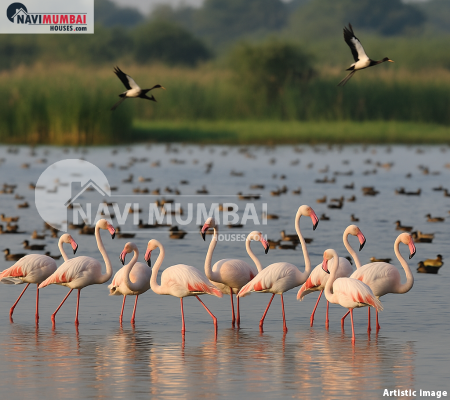
Navi Mumbai’s wetlands face escalating threats from urban development, dumping, infrastructure projects, and regulatory ambiguity. Many of these wetlands play essential ecological roles:
-
They serve as stopover habitats for migratory birds, including flamingos.
-
They act as natural buffers against floods, absorbing excess water, mitigating storm surges, and supporting groundwater recharge.
-
They support biodiversity — mangroves, fish, crustaceans, aquatic plants — and are part of the coastal ecosystem linked to Thane Creek.
-
Their degradation causes ecosystem imbalance, flooding, habitat loss, and environmental stress in urban areas.
Due to development pressure (roads, buildings, casting yards for MTHL, reclamation), wetlands in Navi Mumbai—DPS Flamingo Lake, TS Chanakya, NRI complex, Kharghar wetlands—are being encroached, polluted, filled, or threatened.
Activists have now formally asked Prime Minister Narendra Modi to intervene swiftly, citing the urgency of protection and the scale of loss.
What’s at Stake if Inaction Continues
If urgent action is not taken:
-
Biodiversity Loss: Migratory birds won’t find a safe habitat; species decline.
-
Flood Risks Rise: Without natural water absorption, heavy rains may cause larger floods in Vashi, Nerul, Ulwe, and Panvel.
-
Loss of Ecosystem Services: Wetlands serve filtering, water purification, and carbon sink functions; losing them means more pollution and stress.
-
Urban Heat & Microclimate Issues: Wetlands help cool surroundings; their loss exacerbates heat islands.
-
Irreversible Damage: Once wetlands are filled, reclaimed, or built over, revival is extremely difficult and costly.
-
Public Health & Quality of Life: Poor air & water quality, loss of green spaces, diminished quality of living.3
In 2025, citizens already formed a silent human chain to protect the 30-acre Nerul wetland near DPS Flamingo Lake.
The Maharashtra Forest Minister has backed proposals to declare DPS Flamingo Lake a conservation reserve to provide legal protection.
But planning alone isn’t enough without enforcement, funding, and political commitment.
What Must Be Done & How PM Modi’s Role Can Help
To reverse the decline and ensure long-term protection, the following steps should be considered:
A. Declare Wetlands as Protected / Conservation Areas
-
Fast-track official notification of DPS Flamingo Lake, TS Chanakya, and NRI wetlands as Conservation Reserves or Wetland Reserves under national/state law.
-
Use the National Wetland Rules / Act to designate these wetlands legally, which restricts development, dumping, and filling.
-
Ensure “no net loss” or “no further degradation” norms apply strictly.
B. Enforcement & Monitoring
-
Deploy a special oversight cell under the central ministry (MoEFCC) or PMO to monitor compliance.
-
Use remote sensing, drones, and GIS to monitor encroachments, dumping, and unauthorized construction.
-
Penal action against violators, including demolition, fines, and restoration orders.
C. Integration with Development & Infrastructure Plans
-
Infrastructure projects like NMIA, MTHL, and roads must respect wetlands, avoid casting yards over them, and follow environmental impact assessments with wetlands considered.
-
Wetland buffer zones must be strictly observed.
D. Funding & Restoration Programs
-
Funds from central grants / CSR / green bonds for wetland restoration, mangrove planting, and pollution control.
-
Community-based restoration programs: local stakeholder involvement.
-
Compensation or relocation for informal encroachers in a legal & humane way, but no destructive filling permitted.
E. Citizen Participation & Transparency
-
Ensure local NGOs and citizen groups have access to monitoring data and are part of decision processes.
-
Open data portals on wetland health and violations.
-
Periodic citizen audits of restoration work.
F. Judicial / Policy Backing
-
Direct courts to prioritize petitions regarding wetland protection in Navi Mumbai.
-
Involve the high courts or the Supreme Court directions where needed, to ensure implementation.
If PM Modi actively supports or orders a task force, states and local agencies will follow with greater compliance, given the central authority’s influence.
Call to Action
-
To PMO / Central Government: Issue an urgent directive to the Maharashtra government and local authorities to notify these wetlands as protected zones and to halt all destructive development immediately.
-
To State & Local Bodies (CIDCO, NMMC, municipal corporations, forest dept.): Enforce existing laws, demarcate buffer zones, stop dumping, start restoration.
-
To Citizens & Activists: Continue public pressure, awareness campaigns, petitions, and litigation if needed.
-
To Developers / Infrastructure Planners: Respect ecological limits; propose designs that avoid wetland damage; use eco-sensitive planning.
-
To Media & Opinion Makers: Keep the spotlight on habitat loss, ensure accountability.
Takeaway
Navi Mumbai’s wetlands are not just swamps—they are the lifelines of coastal ecology, migratory bird sanctuaries, flood buffers, and green lungs of urban life. The threats they face today demand urgent, decisive action.
By urging PM Modi’s intervention, activists are pushing the highest level of government to step in — because state or local bodies alone may not be swift enough. With legal protection, strict enforcement, systemic monitoring, and citizen inclusion, these wetlands can be preserved, revived, and sustained for future generations.
If such action is delayed, the cost will be irreversible — ecological, infrastructural, and social. The time to act is now.
Visit Us: http://www.navimumbaihouses.com OR call us on @ 8433959100
The post Protecting Navi Mumbai’s Wetlands: Activists Call on Modi to Lead the Charge appeared first on .

